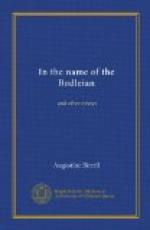In these pages we can see for ourselves the British public—God rest its soul!—enjoying itself. This honest book is full of la bourgeoisie. The rips and the painted ladies occasionally, it is true, make their appearance, but they are reduced to their proper proportions. The Adam and Eve Tea Gardens, St. Pancras, have a somewhat rakish sound, calculated to arrest the jaded attention of the debauchee, but what has Mr. Wroth to tell us about them?
’About the beginning of the present century it could still be described as an agreeable retreat, “with enchanting prospects”; and the gardens were laid out with arbours, flowers, and shrubs. Cows were kept for making syllabubs, and on summer afternoons a regular company met to play bowls and trap-ball in an adjacent field. One proprietor fitted out a mimic squadron of frigates in the garden, and the long-room was used a good deal for beanfeasts and tea-drinking parties’ (p. 127).
What a pleasant place! Syllabubs! How sweet they sound! Nobody worried then about diphtheria; they only died of it. Mimic frigates, too! What patriotism! These gardens are as much lost as those of the Hesperides. A cemetery swallowed them up—the cemetery which adjoins the old St. Pancras Churchyard. The Tavern, shorn of its amenities, a mere drink-shop, survived as far down the century as 1874, soon after which date it also disappeared. Hornsey Wood House has a name not unknown in the simple annals of tea-drinking. It is now part of Finsbury Park, but in the middle of the last century its long-room ’on popular holydays, such as Whit Sunday, might be seen crowded as early as nine or ten in the morning with a motley assemblage eating rolls and butter and drinking tea at an extravagant price.’ ’Hone remembered the old Hornsey Wood House as it stood embowered, and seeming a part of the wood. It was at that time kept by two sisters—Mrs. Lloyd and Mrs. Collier—and these aged dames were usually to be found before their door on a seat between two venerable oaks, wherein swarms of bees hived themselves.’
What a picture is this of these vanished dames! Somewhere, I trust, they are at peace.
’And
there, they say, two bright and aged snakes,
Who
once were Cadmus and Harmonia,
Bask
in the glens or on the warm sea-shore.’
A more raffish place was the Dog and Duck in St. George’s Fields, which boasted mineral springs, good for gout, stone, king’s evil, sore eyes, and inveterate cancers. Considering its virtue, the water was a cheap liquor, for a dozen bottles could be had at the spa for a shilling. The Dog and Duck, though at last it exhibited depraved tastes, was at one time well conducted. Miss Talbot writes about it to Mrs. Carter, and Dr. Johnson advised his Thralia to try the waters. It was no mean place, but boasted a breakfast-room, a bowling-green, and a swimming-bath 200 feet long and 100 feet (nearly) broad. Mr.




